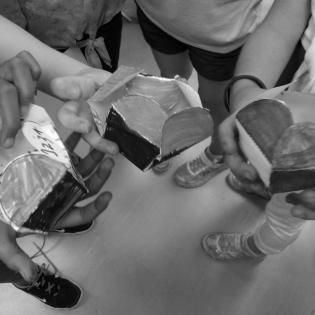Selfless Self-portraits
We learn a little history of the painters Van Gogh and Gauguin who were driven by a need to give of themselves to others through art. Participants study the techniques and draw their own portraits. They make a gift of the portrait to someone.
- Make style and color observations about the portraits and philosophies of Van Gogh and Gauguin.
- Connect how one practices philanthropy related to one's own passions and self-interests.
- books about Van Gogh and Gaugin
- mirrors
- sketch paper and final drawing paper
- art materials, such as pencils, paint, and collage supplies
- Anholt, Laurence. Camille and the Sunflowers: A Story about Vincent Van Gogh. Barrons Juveniles, 1994. ISBN: 0812064097
Instructions
Anticipatory Set:
Read Camille and the Sunflowers: A Story about Vincent Van Gogh (see Bibliography). Reflect on how people reacted to Van Gogh and how he helped others. (He felt that he could give to people who were poor and hard-working by sharing his art with them and painting them.) Ask what makes giving a gift of art an act of philanthropy. Van Gogh and Gauguin exhibited selflessness and had a strong sense of community. They made sacrifices for others that hurt themselves.
- Look together at several examples of the self-portraits and portraits of Vincent Van Gogh and Paul Gauguin. Explore and discuss how Van Gogh and Gauguin interpreted faces.
- Looking at a mirror of self, each participant notes how their unique faces are structured. The facilitator tells them to look at proportions, symmetry, the width of their cheeks and neck, how earlobes connect, and shapes of different features.
- Notice how your face changes when you are smiling with and without an open mouth. Note how different emotions change appearance.
- How many colors can you see in your eyes? Look at the placement of your eyes; they are almost in the middle of your head. How far apart are they? Can you see the whole circle of your iris or does your eyelid cover part of it?
- Model some elements of a self-portrait, using shape and line; sketch with pencil first.
- Discuss how to create the appropriate colors and values using at least four colors. Discuss and show examples of how Van Gogh and Gauguin explored color in their portraits. Discuss how to show texture through color, shape, value and line.
Review the meaning of philanthropy. Sharing artwork with someone else is giving of our talent. It is giving something that took a lot of time and careful work. The opportunity cost of the gift is what was given up in the time to make it.
Talk about who would appreciate the art. It could be a family or friend or an exhibit or auction that benefits others.
Students will create a piece of art and give it to someone who will appreciate it.
Philanthropy Framework
-
Strand PHIL.I Definitions of Philanthropy
-
Standard DP 01. Define Philanthropy
-
Benchmark E.1 Define philanthropy as the giving and sharing of time, talent, or treasure intended for the common good.
-
Benchmark E.4 Define and give examples of selfishness and selflessness.
-
-
-
Strand PHIL.II Philanthropy and Civil Society
-
Standard PCS 03. Philanthropy and Economics
-
Benchmark E.3 Give examples of <i>opportunity cost</i> in philanthropic giving.
-
-
-
Strand PHIL.III Philanthropy and the Individual
-
Standard PI 01. Reasons for Individual Philanthropy
-
Benchmark E.2 Identify why people practice philanthropy related to their own self-interest.
-
-
-
Strand PHIL.IV Volunteering and Service
-
Standard VS 03. Providing Service
-
Benchmark E.1 Provide a needed service.
-
-
